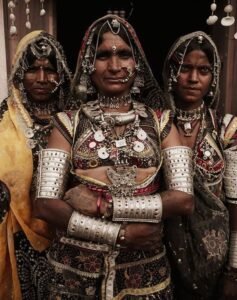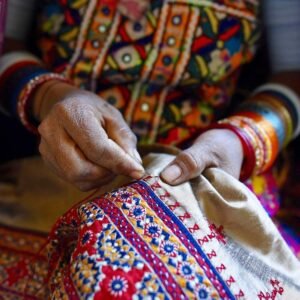India, a land of diverse cultures and traditions, boasts a rich and varied textile heritage. Each region of the country contributes to this legacy with its unique weaving techniques, patterns, and styles, reflecting the cultural and historical influences of that area. In this blog post, we will explore five traditional textiles of India that continue to captivate the world with their beauty and craftsmanship.
1. Banarasi Silk
Banarasi silk, originating from the ancient city of Varanasi (also known as Banaras), is one of the most prized textiles in India. Known for its intricate designs and luxurious feel, Banarasi silk sarees are often adorned with intricate brocades, heavy gold and silver threads, and opulent motifs inspired by Mughal art. These sarees are a staple at weddings and special occasions, symbolizing grace and grandeur.
The making of a Banarasi saree involves meticulous craftsmanship. Skilled weavers use handlooms to create elaborate patterns such as floral designs, kalga and bel, jhallar, and more. The process can take anywhere from 15 days to six months, depending on the complexity of the design.
2. Kanchipuram Silk
Hailing from the town of Kanchipuram in Tamil Nadu, Kanchipuram silk sarees are renowned for their durability and vibrant colors. These sarees are woven with pure mulberry silk threads and feature contrasting borders, often embellished with traditional motifs like temples, peacocks, and flowers.
The distinctiveness of Kanchipuram silk lies in its weaving technique, where the body and border of the saree are woven separately and then interlocked together. This technique not only enhances the durability of the saree but also gives it a striking appearance.
3. Patola
Patola, a double ikat weave from Patan in Gujarat, is known for its precision and geometric patterns. This technique involves resist dyeing, where both the warp and weft threads are dyed before weaving. The process is so intricate that it can take several months to complete a single saree.
Patola sarees are characterized by their vibrant colors and intricate designs, which often include motifs like elephants, parrots, flowers, and dancing figures. These sarees are highly valued for their exclusivity and artistic excellence.
4. Pashmina
Pashmina, originating from the Kashmir region, is a type of fine cashmere wool. Known for its unparalleled softness and warmth, Pashmina shawls and scarves are highly sought after globally. The wool is sourced from the Changthangi goats found in the high altitudes of the Himalayas, and the weaving process is entirely done by hand.
Pashmina shawls often feature intricate hand-embroidered patterns, such as paisleys and floral motifs. The time-consuming process and the delicate nature of the fabric make Pashmina an epitome of luxury.
5. Chanderi
Chanderi, from the town of Chanderi in Madhya Pradesh, is famous for its lightweight and sheer texture. Traditionally woven in cotton and silk, Chanderi fabrics often feature elegant motifs inspired by nature, such as peacocks, flowers, and geometric patterns. The distinguishing feature of Chanderi textiles is the use of zari (gold or silver thread) to create delicate motifs that add a touch of shimmer and sophistication.
Chanderi sarees are known for their subtlety and grace, making them a popular choice for festive occasions and formal events. The fabric is breathable and comfortable, making it suitable for the warm climate of the region.
Conclusion
The traditional textiles of India are not just fabrics; they are a testament to the country’s rich cultural heritage and the incredible skill of its artisans. Each piece tells a story, reflecting the history, beliefs, and artistry of the region it comes from. By preserving and celebrating these textiles, we honor the legacy of India’s diverse and vibrant culture. Whether it’s the opulent Banarasi silk or the ethereal Chanderi, these textiles continue to enchant and inspire, carrying forward the timeless tradition of Indian craftsmanship.




